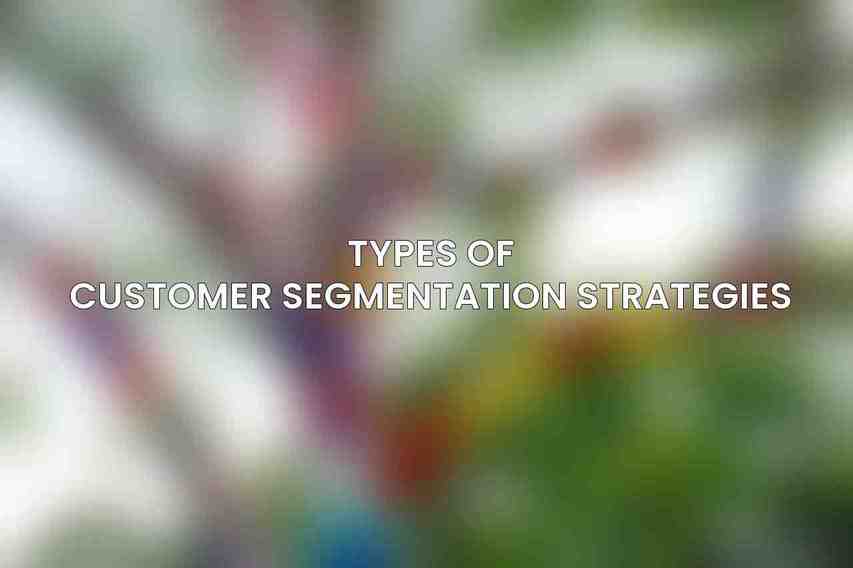understanding the significance of customer segmentation is paramount. By dividing a broad customer base into distinct groups with shared characteristics, e-commerce businesses can tailor their strategies to meet individual needs effectively. This leads to enhanced customer satisfaction, increased loyalty, and ultimately, a higher return on investment (ROI).
Customer segmentation in e-commerce offers a multitude of benefits. By categorizing customers based on specific criteria such as demographics, behavior, or psychographics, businesses can personalize marketing efforts, product offerings, and customer experiences. This targeted approach not only improves customer engagement but also boosts conversion rates and fosters long-term customer relationships.
Types of Customer Segmentation Strategies

A. Demographic Segmentation
Demographic segmentation involves categorizing customers based on quantifiable characteristics such as age, gender, education level, income, and location. Understanding these demographic factors can help e-commerce businesses develop targeted marketing campaigns tailored to specific audience segments.
B. Behavioral Segmentation
Behavioral segmentation focuses on customers’ actions and interactions with the online store. Factors such as purchase history, website browsing behavior, email engagement, loyalty program participation, and customer service interactions are essential for creating personalized experiences and targeted promotions.
C. Psychographic Segmentation
Psychographic segmentation delves into customers’ values, interests, lifestyles, personality traits, and attitudes towards brands. By tapping into these psychological factors, e-commerce businesses can craft compelling messaging that resonates with each segment’s unique preferences and motivations.
D. Custom Segmentation
Custom segmentation employs advanced techniques such as RFM (Recency, Frequency, Monetary) analysis, predictive analytics, and machine learning algorithms to identify patterns and trends within customer data. These sophisticated methods enable businesses to create highly specific segments for customized marketing strategies.
Techniques for Implementing Customer Segmentation
A. Data Collection and Analysis
Effective customer segmentation begins with robust data collection and analysis. Utilizing tools like CRM systems, Google Analytics, customer surveys, and social media monitoring can provide valuable insights into customer behavior and preferences, laying the groundwork for segmentation strategies.
B. Segmentation Tools
Segmentation tools like specialized software, data visualization platforms, and predictive modeling tools streamline the segmentation process and empower e-commerce businesses to make data-driven decisions. These tools enable businesses to identify patterns, forecast trends, and target the right audience segments.
Developing Effective Segmentation Strategies
A. Defining Segmentation Criteria
When developing segmentation strategies, businesses must establish clear and relevant criteria that are measurable and actionable. Segmentation criteria should be mutually exclusive and exhaustive to ensure distinct customer groups and comprehensive coverage.
B. Creating Customer Profiles
Developing detailed customer profiles that incorporate demographic, behavioral, and psychographic data is crucial for effective segmentation. By assigning personas to each segment, businesses can humanize their target audience and tailor marketing efforts accordingly.
C. Developing Targeted Marketing Strategies
Tailoring marketing strategies to meet the unique needs of each segment is essential for driving engagement and conversions. Personalizing messaging, product recommendations, website content, and promotional offers can significantly improve ROI by resonating with customers on a personal level.
Measuring and Optimizing Segmentation Strategies

A. Key Performance Indicators (KPIs)
Tracking key performance indicators such as conversion rates, average order value, customer lifetime value, and ROI provides valuable insights into the effectiveness of segmentation strategies. Analyzing these metrics helps businesses gauge performance and make informed decisions for optimization.
B. Ongoing Optimization
Continuously evaluating and refining segmentation criteria, testing different models, and adjusting strategies based on performance data are essential for maximizing ROI. By maintaining a flexible and adaptive approach to segmentation, e-commerce businesses can stay ahead in the competitive world.
Case Studies
A. Example 1: Amazon’s Customer Segmentation Strategy
Amazon, a pioneer in e-commerce, leverages advanced algorithms and machine learning to segment its vast customer base. By personalizing product recommendations, optimizing user experience, and offering targeted promotions, Amazon has set a benchmark for effective segmentation strategies.
B. Example 2: Netflix’s Personalized Recommendations
Netflix excels in behavioral segmentation by analyzing user viewing preferences and habits to deliver personalized content recommendations. Through sophisticated algorithms and data analytics, Netflix enhances the user experience and fosters customer loyalty.
C. Example 3: Nike’s Segmentation for Athletes and Fitness Enthusiasts
Nike targets distinct segments of athletes and fitness enthusiasts through tailored marketing campaigns, product offerings, and brand messaging. By understanding the unique needs and preferences of these segments, Nike has successfully captured niche markets and built a loyal customer base.
customer segmentation is a fundamental strategy for e-commerce success. By implementing diverse segmentation strategies, businesses can optimize marketing efforts, enhance customer satisfaction, and ultimately maximize ROI. Embracing data-driven segmentation techniques, personalizing customer experiences, and continuously refining strategies are key steps towards achieving sustainable growth in the competitive e-commerce world.
Frequently Asked Questions
What is customer segmentation in e-commerce?
Customer segmentation in e-commerce is the process of dividing your customer base into distinct groups based on certain characteristics, such as demographics, behavior, or preferences.
Why is customer segmentation important in e-commerce?
Customer segmentation in e-commerce is important because it allows you to tailor your marketing efforts and offerings to specific groups of customers, thereby increasing the likelihood of conversions and maximizing ROI.
How can customer segmentation help maximize ROI in e-commerce?
Customer segmentation can help maximize ROI in e-commerce by enabling you to target the right customers with the right messages and offers, leading to improved conversion rates and increased customer loyalty.
What are some common customer segmentation strategies used in e-commerce?
Some common customer segmentation strategies used in e-commerce include demographic segmentation, behavioral segmentation, psychographic segmentation, and geographic segmentation.
How can businesses effectively implement customer segmentation strategies in e-commerce?
Businesses can effectively implement customer segmentation strategies in e-commerce by leveraging data analytics tools to gather and analyze customer data, identifying key customer segments, and developing targeted marketing campaigns and personalized offers for each segment.
